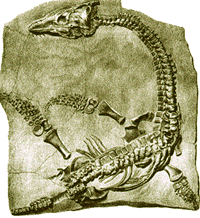Lepidosauromorpha
Taxa on This Page
-
Lepidosauromorpha
Lepidosauromorpha and Lepidosauriformes
The Lepidosauromorphs are one of the two major groups or clades of diapsids that evolved from earlier Permo-Carbiniferous ancestors, the other being the Archosauromorphs. The distinction between these two groups was confirmed by cladistic analysis (Benton, 1985; Gauthier et al 1988). These authors also included a number of basal taxa such as the younginiforms, Palaeagama, Paliguana, and Saurosternon, as well as the more derived forms: kuehneosaurs, rhynchocephalia and squamates (lizards and snakes). All of these taxa share a unique combination of synapomorphies, such as in the morphology of the forelimbs and girdles. But later studies showed that the position of some of the early forms was not so clear cut after all, and finally the younginiforms were banished from the Lepidosauromorphs altogether (Laurin 1991). Following soon after was the controversial thesis by Rieppel and deBraga (Rieppel 1994, Rieppel & deBraga 1996, deBraga & Rieppel 1997) that turtles (Chelonians, Testudines) are closely related to sauropterygians (plesiosaurs and their relatives), and that both groups are lepidosauromorphs ( For an overview of all these developments, see Michel Laurin and Jacques A. Gauthier, Diapsid Phylogeny - Tree of Life page, although this essay, written in 2000, does not cover more recent papers). This was a revolutionary development, as up until then chelonians had almost always been included in the Anapsida on the basis of the lack of fenestration (openings) in the bones of the side of the skull). If Rieppel was right, then fenestrae can no longer be used as a reliable indicator of reptilian relationship. Thus Lepidosauromorpha become an important group that include not only lizards and snakes and their relatives (Lepidosauriformes), but turtles and tortoises, and plesiosaurs and pliosaurs (Sauropterygia). Unfortunately chelonian origins is a very controversal subject, and molecular phylogeny shows unanimously that - contrary to almost all morphological evidence, chelonians are actually archosaurs (well, archosauromorphs), that is, they are more closely related to birds and cerocodiles than to lizards and snakes. Which means that either they did not evolve from early sauropterygians after all, or, another heretical hypothesis, sauropterygians are also archosauromorphs. Again, this is contrary to conventional morphology, although some evidence does seem to be appearing. Some cladograms for example suggest that ichthyosaurs are the sister-group of sauropterygians, and that this clade is part of Archosauromorpha (Merck 1997), or that Ichthyosaurs are more basal Archosauromorphs relative to the Sauropterygia and Chelonia (who in turn are more basal relative to the Archosauria) (Borsuk-Białynicka & Evans 2009 p.230). Which nicely ties in molecular with cladistic phylogeny. However, it goes totally against all morphological evidence, according to which Sauropterygians appear as Lepidosauromorphs (Lee, 2001) or as stem diapsids (Hill, 2005).
If Sauropterygians turn out not to be the sister group of lepidosaurs, then the lepidosauromorpha becomes synonym of the Lepidosauriformes, or vice-versa, and this clade is limited to groups of lizard like forms, very much overshadowed by its glamorous and diverse archosauromorph sibling. Although it should not be forgotten that the squamates are one of the real success stories of vertebrate evolution, thanks to their unique skull and jaw mobility. This reaches its highest development in the Snakes, who in this way are able to swallow prey much larger than themselves.
Mention should also be made of the rather surprising findings of Hill, 2005 who, using a very large taxonomic and character sample to test the phylogenetic position of turtles among amniotes, arrived at the findings that not only were Testudines and Lepidosaurs sister clades, but Turtles + Lepidosaurs are in turn the sister clade to Crown group Archosaurs (Dinosaurs + Crurotarsi). The whole thing is like this: Reptiliomorpha (Mesosauridae (Synapsida (Parareptilia (Captorhinidae (Paleothyris (Araeoscelida (Claudiosaurus (Younginiformes (Basal Archosauromorpha (Kuehneosauridae (Sauropterygia (Archosauria (Lepidosauria + Chelonia))))))))))))) , While with the starting clades this arrangement is in accordance with the consensus of with the general phylogeny of amniotes, the collapsing of Archosauromorpha and Lepidosauromorpha (represented by Kuehneosauridae) into a single stem, with Lepidosaurs way up in the crown goes against the entire Diapsid phylogenetic consensus. As with the contradiction between morphological and molecular data, here the computer intense cladograms contradict the obvious morphological approach (there is a similar contrast between early (Eugene Gaffney) and more recent (Joyce, Anquetin, Sterli, etc) turtle cladograms).
For now, I have retained the current consensus phylogeny, with the Archosauromorpha and Lepidosauromorpha as the two primary lines emerging from an unspecialised neodiapsid/younginiform stem, the Sauropterygians and Lepidosauriformes as sister taxa, and turtles as highly specialised Anapsids. Here following useful tabulation, the first four from Diapsid Characters and Anatomy (University of Bristol) and the last ones from Archosauromorpha (John Meck, study notes), can be used to distinguish the archosauromorpha from the Lepidosauromorpha / Lepidosauriformes / Lepidosauria:
Lepidosauromorpha
|
Archosauromorpha
|
- Sprawling posture/mediolateral excursion (primitive characteristic, shared with basal tetrapods), mediolateral means a more sinuous motion
- Emphasis on lateral undulation of vertebral column (as above)
- Large sternum for rib and muscle attachments
- Wrist and hand unmodified (similar to primitive diapsids)

- cervical (neck) vertebrae unmodified (similar to primitive diapsids)
|
- Limbs are brought more directly under the body (allowing more erect and efficient posture and movement)
- Lateral flexure of vertebral column eliminated (less serpentine movement).
- Small sternum.
- Carpus (wrist) and manus (hand) are more derived reflecting more upright stance

- Overlapping cervical ribs (stiffening of neck)
- Relatively long cervical vertebrae. (this and above mean a long relatively stiff neck)
|
MAK100929, revised MAK101030
Descriptions
postfrontal borders upper fenestra [R89]; supratemporal absent; quadrate wide in posterior view, forming conch; quadrate bowed in lateral view; quadrate foramen absent; retroarticular process large; teeth absent on lateral pterygoid flanges; parasphenoid teeth absent; intercentra absent from trunk vertebrae; accessory vertebral articulations [R89]; dorsal ribs holocephalous [R89]; no bipedal specializations; rigid pectoral girdle; large sternum; overlapping scales.
revised ATW080328, checked ATW030715, last revised MAK101012


